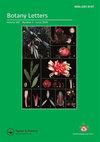New evidence of the architecture and affinity of fossil trees from the Jurassic Purbeck Forest of southern England
IF 1.3
4区 生物学
Q3 PLANT SCIENCES
引用次数: 1
Abstract
ABSTRACT We document the habit and affinity of the most complete Mesozoic Era tree to be excavated in the UK. The fossil was found in situ in a palaeosol of the Upper Jurassic Purbeck Group of southern England (Tithonian: ca. 150–145 million years). It comprises over 100 permineralized (silicified) pieces that represent a rooted stump and fallen trunk, together weighing more than two tonnes. This exceptional specimen was excavated in a manner that retained the original associations among its parts, providing a unique insight into the overall habit and mode of growth. A laser scanning approach was used to facilitate the investigation, producing the largest 3D reconstruction of a plant fossil. Anatomical details reveal that the wood belongs to the fossil-genus Agathoxylon. Despite an estimated growth age of more than 200 years, the tree was of modest size, not greatly exceeding 12 m in height. The main trunk bifurcated, developing into a decurrent, spreading crown. Its habit differed significantly from most modern arborescent conifers, which have pole-like central trunks and narrow, conical crowns, and from known growth forms in the Cheirolepidiaceae, an important extinct group of Mesozoic conifers. These findings extend our knowledge of the growth architecture of Jurassic conifers, which were prominent and diverse elements of seasonally arid, low to mid-latitude coastal communities during the Late Mesozoic. GRAPHICAL ABSTRACT英格兰南部侏罗纪珀贝克森林树木化石的结构和亲缘关系的新证据
摘要:我们记录了英国最完整的中生代树木的习性和亲缘关系。该化石是在英格兰南部上侏罗纪珀贝克群的古土壤中原位发现的。它由100多个经过再矿化(硅化)的碎片组成,这些碎片代表了一个生根的树桩和倒下的树干,总重量超过两吨。这个特殊的标本是以一种保留了其各部分之间原始联系的方式挖掘的,为了解整体习惯和生长模式提供了独特的见解。激光扫描方法被用于促进研究,产生了最大的植物化石三维重建。解剖细节表明,该木材属于玛瑙木化石属。尽管估计生长年龄超过200岁 几年前,这棵树的大小适中,不超过12棵 m高。主干分叉,发育成下延的、展开的树冠。它的习性与大多数现代树状针叶树有着显著的不同,后者有着类似极点的中央树干和狭窄的圆锥形树冠,也与中生代重要的已灭绝针叶树类Cheirolepidiaceae的已知生长形式有着显著差异。这些发现扩展了我们对侏罗纪针叶树生长结构的了解,侏罗纪针叶树是中生代晚期季节性干旱、中低纬度沿海群落中的突出和多样元素。图形摘要
本文章由计算机程序翻译,如有差异,请以英文原文为准。
求助全文
约1分钟内获得全文
求助全文
来源期刊

Botany Letters
Agricultural and Biological Sciences-Plant Science
CiteScore
3.10
自引率
6.70%
发文量
54
期刊介绍:
Botany Letters is an international scientific journal, published by the French Botanical Society (Société botanique de France) in partnership with Taylor & Francis. Botany Letters replaces Acta Botanica Gallica, which was created in 1993, building on over a century of renowned publications by the Société botanique de France.
 求助内容:
求助内容: 应助结果提醒方式:
应助结果提醒方式:


